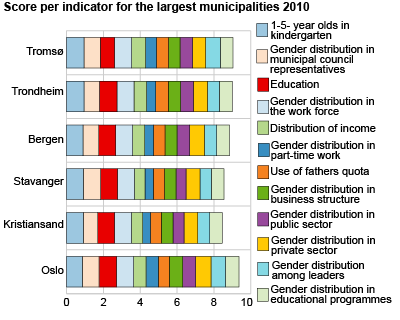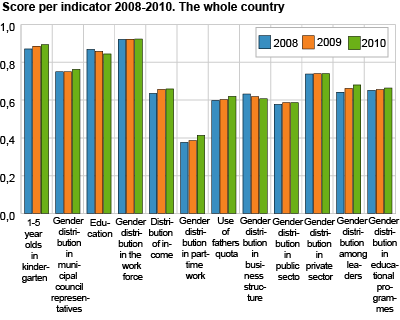Content
Published:
This is an archived release.
Oslo scores high on gender equality
In general, Oslo scores consistently higher than the rest of Norway’s municipalities on Statistics Norway’s twelve indicators that measure gender equality. We have seen a change towards more gender equality in many municipalities since 2008, but the changes are small.
Municipalities in Eastern and Northern Norway have on average higher scores on the gender equality indicators than municipalities in Southern and Western Norway. The pattern that has been prominent for the regional gender equality therefore remains stable. Generally the indicators related to the ratio between women and men’s part-time work and men and women’s gross income still have the lowest score levels, while the indicators related to 1-5 year olds in kindergarten and the relationship between men and women's employment have high score levels.
Indicators for Gender equality in Norwegian municipalitiesSince 1999, Statistics Norway has published an index on gender equality in all 430 Norwegian municipalities. The index was changed in 2009, including more indicators and a more composite method. As of 2012 a composite measure for gender equality will no longer be specified, but equality in the municipalities will be measured through a set of 12 indicators that are considered important and relavant to describe local gender equality. These are the same indicators as in the revisted index 2009-2010. Gender equality can be measured in different ways. The selected indicators for gender equality in Norwegian municipalities correspond to internationally used indicators of gender equality, but they are also adapted to Norwegian conditions. The indicators are based on available annual register statistics. For more information about the indicators, data source and method, see About the statistics and Note 2009/65 (in Norwegian only). |
Low shares of female part-time work in Oslo and Akershus
Eastern, Central and Northern Norway, and especially Oslo and the county of Akershus, score high on many of the gender equality indicators. Oslo and Akershus stand out with equal educational level between men and women, more equal distribution of men and women in the private sector and low shares of female part-time work, compared to other municipalities. Of the 20 municipalities in the country with the lowest proportion of women in part-time work 14 of these are municipalities in Akershus.
The indicator for part-time work is among the indicators that vary most between the municipalities. Many municipalities in Northern and Central Norway also scores higher than the average on the part-time indicator. In these municipalities however, higher scores are related to the fact that more men work part-time in these areas, combined with relatively few women. Municipalities in South and Western Norway generally score low in part-time work. In these municipalities this is related to many women working part-time and very few men.
Income disparities in Southern and Western Norway
Opposite of municipalities in Central and Northern Norway municipalities in Southern and Western Norway score relatively low on the majority of the equality indicators. The main pattern is, in addition to low scores on part-time work, a high degree of income disparities and a skewed distribution of municipal council representatives. The uneven distribution of men and women in the private and public sectors with regard to the workplace, is also a general feature of these municipalities.
With regard to income disparities, it is however a general pattern throughout Northern Norway, especially in Finnmark, that there is little or no difference between men and women. It can be worth noting that the general level of income among men in the northern municipalities is consistently lower than for men in other municipalities while women’s income on average is higher.
High share of fathers with parental leave in Sogn og Fjordane
The municipalities in Sogn og Fjordane stand out in comparison to other municipalities as having a particularly high share of fathers taking the statutory paternity leave or more of the parental leave in connection with childbirth.
Gender equality in the largest municipalities
All of the six largest cities - Oslo, Kristiansand, Stavanger, Bergen, Trondheim and Tromsø - score high on most indicators compared to other municipalities in their region. For some indicators, however, the cities lie below the average. Oslo stands out as having a lower share of 1-5 year olds in kindergarten and a lower share of fathers taking statutory paternity leave or more. Kristiansand has the most skewed distribution of municipal council representatives and Stavanger scores the lowest with regard to income. Most of the cities are among the municipalities with most equality in educational level between men and women. This is not the case for Tromsø
| Indicators | 2008 | 2009 | 2010 | ||||||||||||||||||||||||||||||||||||||||||||||||||||||||||||||||||||||||||||
|---|---|---|---|---|---|---|---|---|---|---|---|---|---|---|---|---|---|---|---|---|---|---|---|---|---|---|---|---|---|---|---|---|---|---|---|---|---|---|---|---|---|---|---|---|---|---|---|---|---|---|---|---|---|---|---|---|---|---|---|---|---|---|---|---|---|---|---|---|---|---|---|---|---|---|---|---|---|---|---|
| Share of 1-5 years olds in kindergarten | 87.1 | 88.5 | 89.3 | ||||||||||||||||||||||||||||||||||||||||||||||||||||||||||||||||||||||||||||
| Share of women among municipal council representatives | 37.5 | 37.5 | 38.2 | ||||||||||||||||||||||||||||||||||||||||||||||||||||||||||||||||||||||||||||
| Share of men with higher education | 23.7 | 23.9 | 24.0 | ||||||||||||||||||||||||||||||||||||||||||||||||||||||||||||||||||||||||||||
| Share of women with higher education | 27.3 | 27.8 | 28.4 | ||||||||||||||||||||||||||||||||||||||||||||||||||||||||||||||||||||||||||||
| Share of men 20-66 years in the work force | 84.6 | 83.9 | 79.4 | ||||||||||||||||||||||||||||||||||||||||||||||||||||||||||||||||||||||||||||
| Share of women 20-66 years in the work force | 78.0 | 77.4 | 74.4 | ||||||||||||||||||||||||||||||||||||||||||||||||||||||||||||||||||||||||||||
| Average gross income men (NOK) | 423 100 | 419 100 | 433 200 | ||||||||||||||||||||||||||||||||||||||||||||||||||||||||||||||||||||||||||||
| Average gross incomewomen (NOK) | 269 000 | 275 400 | 285 600 | ||||||||||||||||||||||||||||||||||||||||||||||||||||||||||||||||||||||||||||
| Share of employed men working part-time | 13.6 | 13.8 | 15.1 | ||||||||||||||||||||||||||||||||||||||||||||||||||||||||||||||||||||||||||||
| Share of employed women working part-time | 36.1 | 35.7 | 36.4 | ||||||||||||||||||||||||||||||||||||||||||||||||||||||||||||||||||||||||||||
| Share of fathers taking the full fathers quota or more | 59.8 | 60.3 | 62.0 | ||||||||||||||||||||||||||||||||||||||||||||||||||||||||||||||||||||||||||||
| Gender balanced business structure (score) | 0.64 | 0.62 | 0.61 | ||||||||||||||||||||||||||||||||||||||||||||||||||||||||||||||||||||||||||||
| Share of women in public sector | 70.7 | 71.1 | 70.7 | ||||||||||||||||||||||||||||||||||||||||||||||||||||||||||||||||||||||||||||
| Share of women in private sector | 37.0 | 37.0 | 36.9 | ||||||||||||||||||||||||||||||||||||||||||||||||||||||||||||||||||||||||||||
| Share of women among leaders | 32.1 | 33.1 | 33.9 | ||||||||||||||||||||||||||||||||||||||||||||||||||||||||||||||||||||||||||||
| Gender balance in educational programs in upper secondary school (score) | 0.65 | 0.66 | 0.66 | ||||||||||||||||||||||||||||||||||||||||||||||||||||||||||||||||||||||||||||
Towards more gender equality?
From 2008 to 2010 the development for the country as a whole shows a relatively modest change towards more gender equality in several indicators. Especially for the share of 1-5 year olds in kindergarten, the distribution of men and women in municipal council representatives and the distribution of part-time work, there has been an increase. The same accounts for the share of fathers taking the fathers quota or more of the statutory leave. The indicator for the relationship between men and women's education has decreased steadily during this period. In sum, we can say that we are seeing a change toward higher scores on the majority of the indicators, but the tendency is that the changes are small.
Tables:
Additional information
The indicators of gender equality in municipalities has been published every year since 2008. The indicators are based on available statistics from registers, and measure gender equality in all municipalities and counties, as well as average for the whole country.


